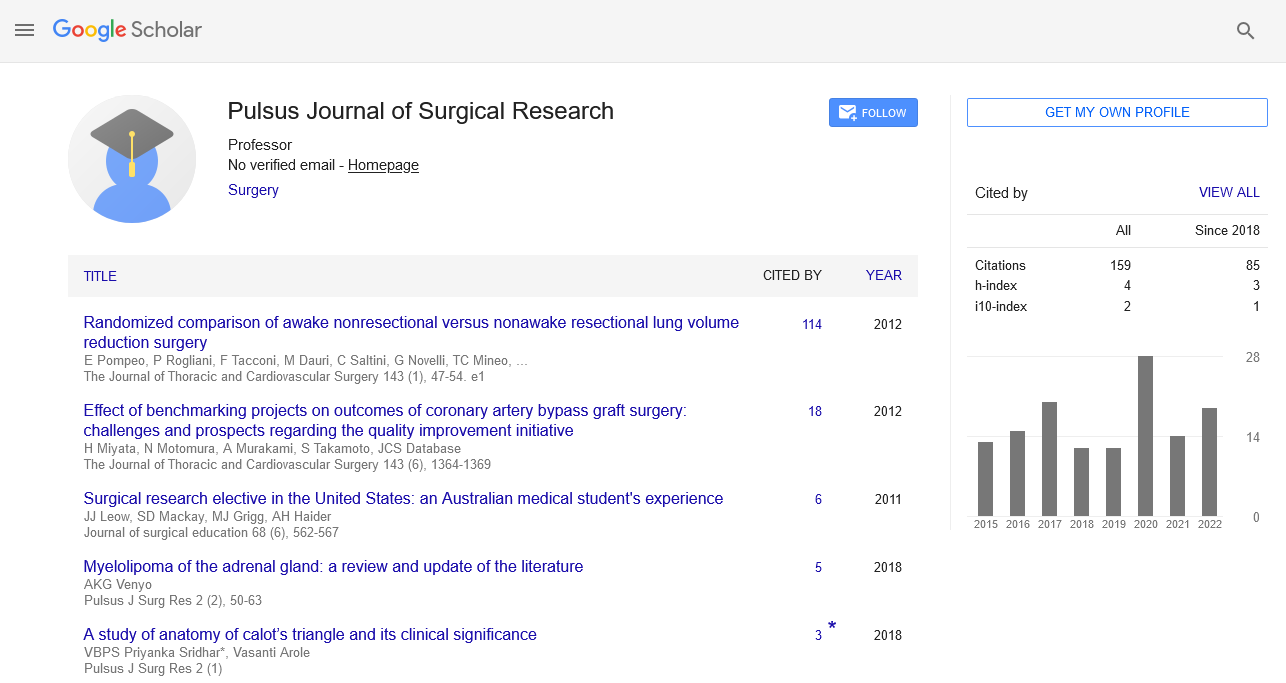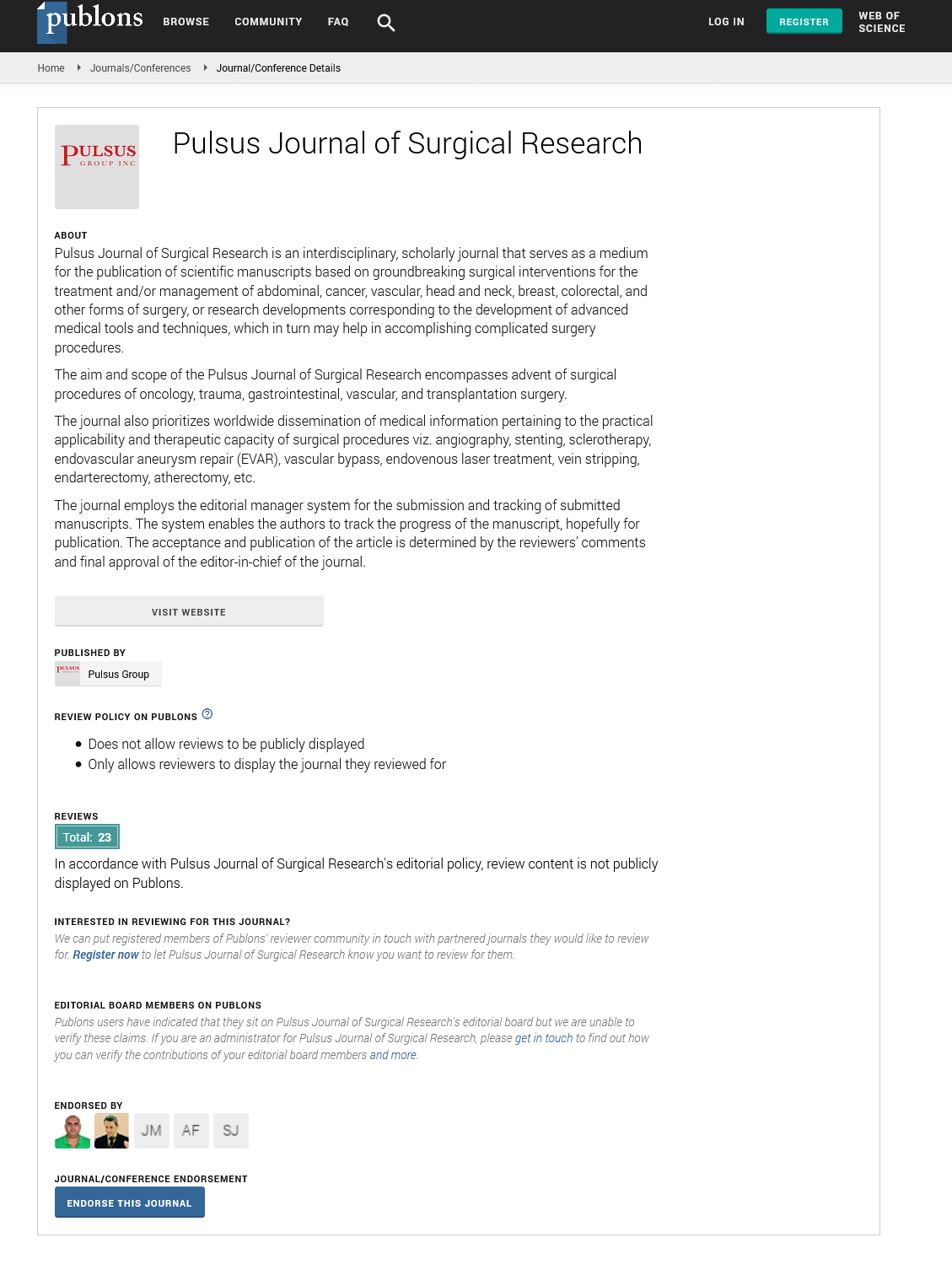Circulating fibrocystic is used to diagnose acute appendicitis
Received: 03-Jun-2022, Manuscript No. pulpjsr- 22-5674; Editor assigned: 06-Jun-2022, Pre QC No. pulpjsr- 22-5674 (PQ); Accepted Date: Jun 26, 2022; Reviewed: 18-Jun-2022 QC No. pulpjsr- 22-5674 (Q); Revised: 24-Jun-2022, Manuscript No. pulpjsr- 22-5674 (R); Published: 30-Jun-2022
Citation: Lewis S . Circulating fibrocystic is used to diagnose acute appendicitis. J surg Res. 2022; 6(3):37-39.
This open-access article is distributed under the terms of the Creative Commons Attribution Non-Commercial License (CC BY-NC) (http://creativecommons.org/licenses/by-nc/4.0/), which permits reuse, distribution and reproduction of the article, provided that the original work is properly cited and the reuse is restricted to noncommercial purposes. For commercial reuse, contact reprints@pulsus.com
Abstract
It is necessary to develop better diagnostic biomarkers for acute appendicitis. Although the circulating fibrocystic percentage (CFP) is elevated in inflammatory conditions, acute appendicitis has not been researched. This study compared the diagnostic efficacy of standard serological indicators with CFP in acute appendicitis. Prospective cohort research was conducted. Fluorescence-activated cell sorting was used to dual-stain peripheral venous samples for CD45 and collagen I, which allowed for the determination of the CFP and its correlation with histological diagnoses. White cell count, C-reactive protein concentration, neutrophil count, lymphocyte count, and neutrophil to lymphocyte ratio were used to characterise and compare the accuracy of CFP in identifying histological acute appendicitis. The CFP is elevated in acute appendicitis that has been histologically proven, and it can diagnose the condition just as precisely as conventional serological indicators.
Key Words
Hepatobiliary; Surgical care; Oncology; Brest cancer; Vascular surgery
Introduction
Acute surgical admissions are most frequently caused by suspected Aacute appendicitis. Accurately diagnosing acute appendicitis remains difficult in clinical practice despite how frequently the condition occurs. This is partly because other intra-abdominal illnesses including mesenteric adenitis and ovarian pathology have many of the distinctive symptoms and indications. The reported negative appendectomy rates, which can reach 30% in surgical patients, are indicative of this diagnostic conundrum. These reported NARs underscore the need for an accurate preoperative examination and draw attention to the shortcomings of the present diagnostic procedures. Several studies have looked into the use of biomarkers for the diagnosis of acute appendicitis, such as white cell count and Creactive protein. Although these biomarkers are widely used and inexpensive, they have drawn criticism for their poor ability to diagnose acute appendicitis [1]. The neutrophil: lymphocyte ratio, which is produced from the various white blood cells, is another straightforward biomarker. Studies have shown that NLR plays a limited diagnostic function in acute appendicitis but is an effective predictor of complex appendicitis. The diagnostic precision of acute appendicitis has increased, and the NAR has decreased, because of radiological studies including CT, MRI, and ultrasound imaging. However, conventional CT procedures exposing patients to significant radiation doses increase their lifetime chance of developing specific cancer subtypes [2]. Despite this, there is mounting evidence that the widely used appendicitis investigation procedure, low-dose CT with intestinal contrast, enables highly precise diagnostics with minimal radiation exposure. On the other hand, ultrasound examination is a less expensive and radiationfree imaging method. Though less sensitive than MRI and CT for acute appendicitis, it is operator-dependent. The hematopoietic cells known as circulating fibrocystic, which circulate in the monocyte fraction and can differentiate into myelofibrocytes, fibroblasts, and adipocytes, are derived from the bone marrow. Both inflammatory and healing processes heavily rely on them. Prior research by the authors' team has shown that circulating fibrocystic are more prevalent in the mesentery in Crohn's disease, where they appear to cross the mesentery to reach the serosa surface of the gut [3, 4]. They actively contribute to tissue remodeling by secreting fibro genic and antigenic growth factors like fibroblast growth factor, endothelin, vascular endothelial growth factor, platelet-derived growth factor A, and macrophage colonystimulating factor 30. They also produce a variety of cytokines like tumor necrosis factor and interleukin. The etiology of primary and secondary me enteropathies may be significantly influenced by the circulating fibrocystic percentage, according to some theories. The use of circulating fibrocystic percentage in the diagnosis of acute appendicitis has not been investigated in any studies as of yet. In order to compare the circulating fibrocystic percentage between acute appendicitis patients and healthy controls, was the study's initial goal. In comparison to conventional serological biomarkers, the diagnostic efficacy of circulating fibrocystic percentage in the diagnosis of acute appendicitis was also evaluated. Healthy controls had their blood samples obtained as well. Histopathological analysis performed following the appendectomy supported the diagnosis of appendicitis. The patient’s written informed consent was obtained before a sample of their venous blood was taken [5]. Three groups of patients who underwent an appendectomy were identified: those with appendicitis that was histologically proven, those with an appendix that was histologically proven to be normal, and those with an alternative diagnosis. In the right iliac fossa of two individuals, there were radiological signs of inflammation. Because the surgeon choose not to perform surgery on these patients, both were assigned to the alternative diagnosis group. The decision of whether to perform an appendectomy was left up to the operating surgeon when the appendix seemed macroscopically normal during laparoscopy. Date of admission, patient sex, age, present symptoms, and duration of symptoms, circulating fibrocystic percentage, preoperative WCC and differentials (NLR and neutrophil, lymphocyte, monocyte, basophil, and eosinophil counts), CRP level, a procedure performed, clinical diagnosis, and postoperative histological diagnosis were all included in the data collection. The patient’s peripheral venous samples were taken. Venipuncture was used to obtain a single 10-ml sample of heparinized venous blood from a peripheral arm. The University of Limerick's lab received the samples in sodium heparin (EDTA) vacutainer tubes after they had been collected. After that, samples were processed using density gradient centrifugation (His opaque; Sigma-Aldrich, Wick low, Ireland) to separate the buffy coat layer. Following this, the peripheral blood mononuclear cells were washed in phosphate-buffered saline (PBS), suspended in freezing media (50% fetal bovine serum, 40% RPMI medium, and 10% dimethyl sulphoxide), and then transferred to cryogenic vials in 1 ml aliquots. Before processing for flow cytometry, samples were lastly cooled to 80°C in a cryogenic temperature control rate container. Patients with appendicitis that was histologically verified to have been present had considerably higher circulating white cell (CFP) levels than those with an appendix that was histologically normal. Increases in the number of fibrocystic in circulating white cells may therefore be diagnostic in patients who come with appendicitis suspicion. The study also discovered that circulating fibrocystic percentage had diagnostic accuracy comparable to other serological biomarkers that are frequently evaluated and employed in the diagnosis of acute appendicitis, such as WCC and CRP. Additionally, when regression analysis was done on these biomarkers, including circulating fibrocystic percentage, age, and sex, only circulating fibrocystic percentage was kept as an independent predictive factor for acute appendicitis. In order to diagnose acute appendicitis, circulating fibrocystic percentage may therefore offer helpful diagnostic information. Circulating fibrocystic percentage contribution to acute appendicle inflammation has not yet been studied. In addition to showing that the circulating fibrocystic percentage is elevated in patients with acute appendicitis, this study also shows that the fraction of fibrocystic in circulating white cells may be useful for diagnosing individuals who have appendicitis suspicion. In response to both generalized and localized inflammatory situations, the circulating fibrocystic percentage rises. The intestinal mesenchymal cells, which are made up of a variety of cell types with related origins, functions, and molecular markers, are a component of circulating fibrocystic. However, fibrocystic stand out because they display markers for both mesenchymal and hematopoietic cells. They are capable of differentiating into adipocytes, fibroblasts, and myelofibrocytes (as well as other cell types). It is thought that damage to the gut mucosa stimulates circulating fibrocystic. He diagnoses acute appendicitis; WCC and CRP are the most often employed biomarkers for this purpose [6]. These biomarkers are affordable, but their diagnostic precision is constrained. Procalcitonin, urinary serotonin levels, and IL-6 are recent biomarkers for acute appendicitis. These have demonstrated strong diagnostic potential, but since they are expensive48, they are not now routinely used in clinical practice. The Right Iliac Fossa Treatment study team looked at many models to find patients at low risk of developing acute appendicitis. This verified 15 risk prediction models in UK women and men between the ages of 16 and 45. The models considered were built on the basis of biochemical tests, imaging, and clinical history and examination. While the Appendicitis Inflammatory Response score was the best model for men, the Adult Appendicitis Score had the highest specificity for predicting women at low risk of acute appendicitis. As a result, certain prediction models can assist in identifying patients with a low chance of developing acute appendicitis, lowering the NAR. It is still unknown whether its potential usefulness differs between low- and high-risk groups. The most accurate and precise test for the diagnosis of acute appendicitis is now computed tomography (CT). However, there are issues with cost-effectiveness, accessibility, and radiation dangers, and there is evidence that radiation from routine CT increases the incidence of soft tissue and hematological malignancies in younger people. Furthermore, CT is not frequently accessible in emergency rooms. The CFP may not be as accurate as CT on its own, but it is possible that it may be combined with other biomarkers to produce a scoring system that is equally accurate. Future research should be done in this area.
References
- Ko ES, Morris EA. Abbreviated magnetic resonance imaging for breast cancer screening: concept, early results, and considerations. Korean j radiol. 2019;20(4):533-41.
- Kalser MH, Barkin J, Macintyre JM. Pancreatic cancer. Assessment of prognosis by clinical presentation. Cancer. 1985; 56(2):397-402.
- Weir HK, Johnson CJ, Ward KC, et al. The effect of multiple primary rules on cancer incidence rates and trends. Cancer causes & control. 2016; 27(3):377-90.
- Polyak K, Vogt PK. Progress in breast cancer research. Proceedings of the National Academy of Sciences. 2012; 109(8):2715-7.
- Pandey V, Kumar V. Breast Cancer Care-It’s Time to Rethink and Redesign. J Clin Exp Pathol. 2014; 4:e118.
- Malhotra R, Shah KB, Chawla R, et al. Tolerability and biological effects of long-acting octreotide in patients with continuous-flow left ventricular assist devices. ASAIO Journal. 2017; 63(3):367-70.






